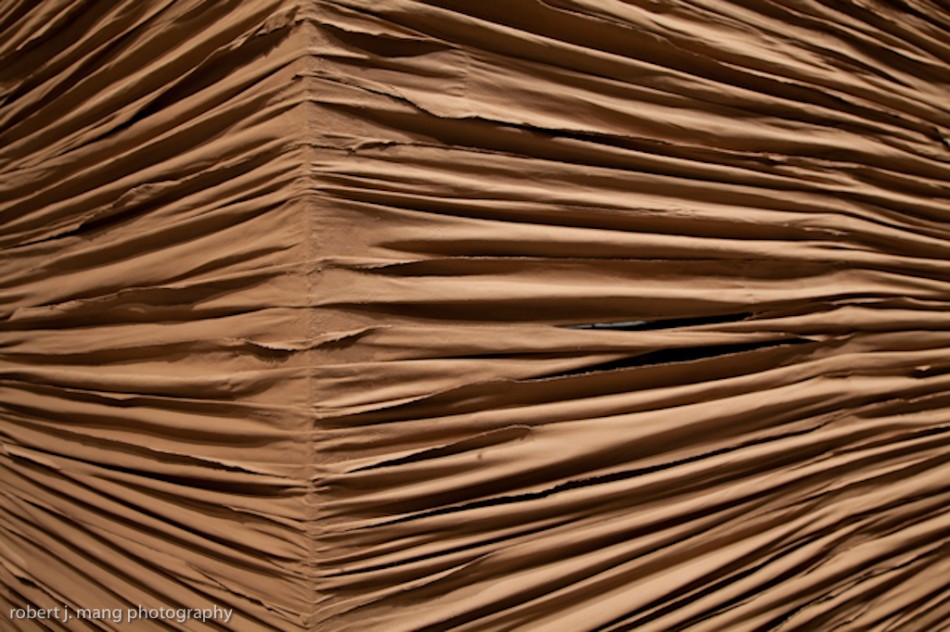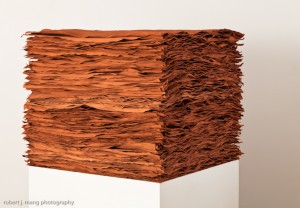
Alison Keogh on Cracked Earth, “Cloaked Earth,” and the Artist’s Journey
Alison Keogh’s show, Arrythmic Visions (on view concurrent with new work by Jamie Hamilton) can be seen at Center for Contemporary Arts, Santa Fe, through June 10. Donna Ruff recently interviewed her. Visit Alison Keogh’s website by clicking this link.
Let’s start with your connection to place. You moved here in 2010 and you’ve mentioned in your artist’s statement that you led a “nomadic existence.” What brought you here and how was your life nomadic?
I grew up in England and moved to Southern California in ‘85. I moved to Belgium in 2001, lived there for four years, re-patriated to Seattle, lived four years and then moved to Santa Fe. Why am I here? Living in So Cal I had my first experience of a desert and fell in love! I visit deserts whenever I can. So now I get to live in one!

Alison Keogh installing Cloaked Earth at Center for Contemporary Arts, Santa Fe
Where did you go to school?
I studied Architecture and got licensed in the UK at Kingston University. I really haven’t been to “art school”, community college in the evenings for painting and then ceramics in S.Cal. When I was in Belgium I went to an Ecole des Arts in a small town outside Brussels. I took a class called “practiques experimental”. It was great, I was free to explore any materials I liked. It was also very difficult all in French and with so much freedom where do you start?
Were you practicing architecture at the same time as you were going to art classes?
I couldn’t practice in Belgium. But while I was in California I was doing both things at the same time. I had my own architectural business which gave me some freedom with the ceramics that I was working on at the time.
So your interest in clay goes back to your ceramic work. I also see a lot of your interest in architecture. For instance, “Cloaked Earth” seems to be a wall that has been created from clay and fabric- it’s free standing, but the scale of it suggests a wall. You’ve deliberately left some areas open in the wrapping, where the knots are in the fabric, and I wonder if there is a bit of denying the permanence of the wall in your work. In the wall works too.

Cloaked Earth installation, Alison Keogh. Photo: Robert J. Mang
Yes, my feeling about clay goes back aways – it’s so tactile and immediate, you really don’t need any tools to “be” with it. I always get excited when I see dried up cracked earth – I love to step on it with my bare feet. As to the “Cloaked Earth” sculpture, yes it’s very architectural, but I see it being an enclosure more than a wall. Its size was determined by the access to my studio and the short time I had to prepare for the exhibition. I sewed many sections of the fabric to join them so that there wouldn’t be knots all over the work, and I deliberately controlled where they appear. This is a rather mysterious and somber piece for me.
 It’s almost funereal in a way. You know that in Orthodox Judaism, and I believe in Muslim ritual as well, the corpse is wrapped and buried in a pine box, meant to decay. Not unlike in ancient Egypt, except there is no embalming done either. Quite different from our cleaned up version of death here in the States.
It’s almost funereal in a way. You know that in Orthodox Judaism, and I believe in Muslim ritual as well, the corpse is wrapped and buried in a pine box, meant to decay. Not unlike in ancient Egypt, except there is no embalming done either. Quite different from our cleaned up version of death here in the States.
It definitely has something to do with the recent death of my mother – sometimes it takes a while for things to be revealed.
I had a similar experience when my mother died- it definitely impacted my work. I do want to talk about the ephemeral nature of your work though. There’s kind of an inconsistency between your wanting to be connected to the earth, and the fact that much of your work is impermanent. Thinking about New Mexico, with its many cultures that have been here for many many generations, and then those of us who are new here, perhaps seeking some permanence in our home, digging roots in the earth in a way. I see some of that in your work.
I think that there are places in the world that we resonate with and we just “feel at home”. I did literally fall into the earth here on a hike up to Picacho Peak, but I think that’s an outward manifestation of how I feel about being here. As for impermanence, nothing is permanent and I think that it’s important that we as humans come to terms with this knowledge. I have never felt that my work should be “permanent” of course this makes it difficult for galleries! I think that in my ceramics experience I got very used to letting go because I would work very thin and things would break.
 “Repose” references Tibetan sand mandalas. I noticed that it was not on the floor though- it’s placed on a pedestal, and it seems related to the idea of margins. Your wall pieces also have margins top and bottom, they don’t reach the ceiling or floor.
“Repose” references Tibetan sand mandalas. I noticed that it was not on the floor though- it’s placed on a pedestal, and it seems related to the idea of margins. Your wall pieces also have margins top and bottom, they don’t reach the ceiling or floor.
I definitely have an interest in Buddhism. For me the work is about the process, which is very concentrated and mindful and involves my body. I would like to install a whole room of sand piles directly on the floor – it was more of a practical issue to place the work on a pedestal. The wall installations were deliberately not up to the full extent of the panel. This was to maintain a more landscape format in keeping with the sense of the earth where the materials originated. The work does not extend to the floor because it would be physically impossible to apply the clay with my forearm any lower!
Good, so this brings me to my next question, about gesture. The two pieces have slightly different gestural marks. also the one on the left, Exit 264, allows the gesture to define the lower boundary of the piece, but the other one is defined by a hard line. Both allow some spatters of the clay. Are you thinking of the specific gesture, do you listen to music, does it have to do with breath?
That’s an interesting question. Gesture is very important to me. The marks are different on each wall due to the nature of the clay. In my studio I had first installed the red clay (Exit 264) and tested the dark brown clay (Exit 297) and anticipated a similar mark. However when I started working with the chocolate clay it reacted very differently- it is almost imperceptibly coarser and I was unable to let it glide as easily across the wall, resulting in a more staccato feeling. Yes, I listen to music when I do this work because it really becomes a dance with the wall and the clay. Some people have said that it feels like poetry or calligraphy, but I don’t think about it, I just participate with the clay the wall and the music. The hard line at the edge of the chocolate wall – that’s the architect in me. Because the gesture is shorter than the red one I didn’t like the way that it felt. The drips are just what happens naturally as I place the clay on the wall with my forearm.
So how do you position your work with your countrymen, Andy Goldsworthy and Richard Long? And what’s with you Brits, that you feel the need to play with dirt?
I feel honored that you have included me in such a line up! Yes, their work has influenced me, along with Guiseppe Penone, Wolfgang Laib, Lee Ufan, Cornelia Parker and many others. Maybe we just have a lot of mud and rain in Britain, but I did grow up making mud pies and playing space ships in the garden!
